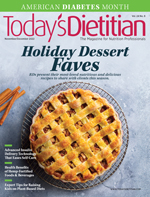 Ask the Expert: What Constitutes One Drink of Alcohol?
Ask the Expert: What Constitutes One Drink of Alcohol?
By Toby Amidor, MS, RD, CDN, FAND
Today’s Dietitian
Vol. 24 No. 8 P. 8
Q: My clients have been discussing various alcoholic beverages they’re consuming. Many contain different strengths of alcohol (or percent of alcohol by volume [% ABV]). Does this matter when it comes to the serving size of alcoholic beverages?
A: Absolutely. Both the volume of the alcoholic beverage and the % ABV play a role in the serving size and calories. Below are the USDA’s Dietary Guidelines for Americans’ (DGA) recommendations for drink equivalents of alcoholic beverages and how to calculate the drink equivalent of alcoholic beverages with various percentages of ABVs.1
Alcoholic Drink Equivalent of Beverages
The recommendations for alcoholic beverages in the DGA are one drink per day for women and two drinks per day for men.1 That begs the question: What exactly is a drink? According to the DGA, one alcoholic drink equivalent contains 14 g (0.6 fl oz) of pure alcohol.1 Based on this information, the DGA provides reference beverages for one alcoholic drink equivalent:
• 12 fl oz of regular beer (5% ABV);
• 5 fl oz of wine (12% ABV); and
• 1.5 fl oz of 80-proof distilled spirits (40% ABV).
Canned alcoholic beverages also have become popular, with a 12 fl oz canned, ready-to-drink beverage at 5% ABV considered a standard drink equivalent.
However, determining the actual drink equivalent has become more complicated than just knowing the volume of the alcoholic beverage. With so many craft beverages and canned cocktails on the market with varying alcohol content, you can’t assume that 12 fl oz of beer, 5 fl oz of wine, 1.5 fl oz of 80-proof distilled spirits, and 12 fl oz of canned cocktails are one drink—often they’re not.
Calculating Drink Equivalents
To calculate drink equivalents, use the following formula:
• [(X fl oz x % ABV) ÷ 0.6 fl oz ethanol] = Y standard drinks
So, if you have a 16 fl-oz can of an 8% ABV beverage, that would equate to more than two standard drinks: [(16 fl oz x 0.08) ÷ 0.6 fl oz ethanol] = 2.13 standard drinks.
Many clients may not have the education level or desire to sit down and calculate drink equivalents when choosing to consume an alcoholic beverage. Besides drinking more alcohol, consuming an alcoholic beverage that’s higher than one standard drink also means calories increase. To make calculating a drink equivalent easier, the Distilled Spirits Council of the United States’ website StandardDrinks.org features a drink calculator to assist adult consumers in making responsible decisions regarding alcohol consumption.
When using the calculator (standarddrinks.org/calculator) clients need only enter two pieces of information to calculate how many standard drinks are in a container or bottle: 1) the volume in oz or mL, and 2) % ABV or “proof.” The calculator works for beer, wine, distilled spirits, canned cocktails, and other ready-to-drink beverages regardless of whether they’re spirit, wine, or malt based. Some India pale ales (IPAs) are examples of drinks that exceed one drink equivalent. With 12% ABV in a 12 fl-oz bottle, that would equate to 2.4 drink equivalents. Other examples are some Chardonnays with 14.8% ABV for a 5 fl-oz serving, which equates to 1.23 drink equivalents.
Recommendations for Dietetics Professionals
Alcohol is alcohol, and no one alcoholic beverage is “safer” or “healthier” than another. That’s an important message to send to clients. Believing that one type of alcohol is better for you is a dangerous idea clients may hold. All alcoholic beverages should be consumed in moderation. When counseling clients, remind them:
• If you choose to drink, it’s recommended to consume no more than one drink per day for women and two drinks per day for men.
• The serving size and % ABV play a role in determining an alcoholic drink equivalent. Determine clients’ favorite alcoholic beverages and educate them about how to calculate the drink equivalents by hand or how to use the Distilled Spirits Council’s calculator to determine how many drink equivalents they’re consuming.
• Clients can’t save all their drinks for a Friday or Saturday night. This is a very common question. The recommendations are daily maximums and can’t be accumulated over days.
• For mixed alcoholic beverages, mixers, soda, and sugar add excess calories and sugar.
— Toby Amidor, MS, RD, CDN, FAND, is founder of Toby Amidor Nutrition (tobyamidornutrition.com) and a Wall Street Journal bestselling author. She’s written nine cookbooks, including Diabetes Create Your Plate Meal Prep Cookbook: 100 Delicious Plate Method Recipes and The Family Immunity Cookbook: 101 Easy Recipes to Boost Health. She’s also a nutrition expert for FoodNetwork.com and a contributor to U.S. News Eat + Run and other national outlets.
Reference
1. US Department of Agriculture. Dietary Guidelines for Americans 2015–2020: Appendix 9. https://health.gov/sites/default/files/2019-09/2015-2020_Dietary_Guidelines.pdf. Published December 2015.